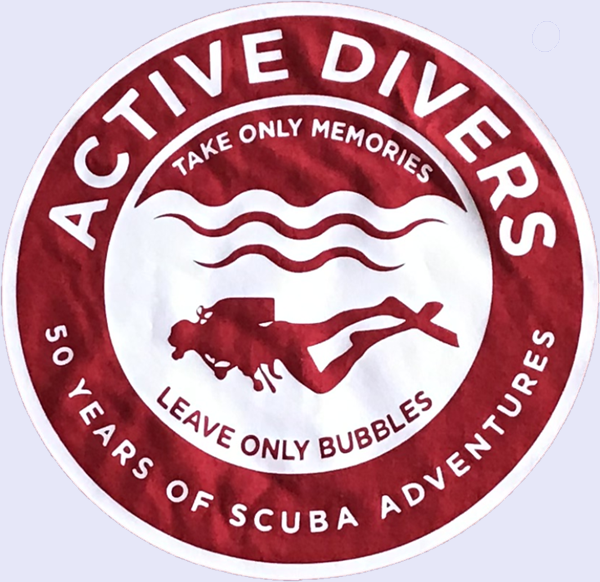![]()
- 2019 - 2020 International Dive Trip Update
- Scuba Skills Tune-Up Event
- Why I Dive
- New Dawn of the Age of Aquarius
- New Dive Products: Scubapro G-2
- 2019 Coral Restoration Program
- Dolphin Facts
- Diving, Then and Now, 50 Years Later
- New Picnic Venue Offers Great Diving and Prizes
- Sad Statistics
- How Much Do Marine Plants Contribute to Earth’s Oxygen Supply?
- Newsletter Delivery Options
- Email or Address Change?
- T-Shirts For Sale
- Active Divers Guidelines & Policies
Tahiti May 28 - June 17, 2019

This trip is less than a month away, so I am not anticipating adding more participants. Final details are being planned, dives and tours scheduled and the excitement is growing as the group collaborates on the activities. We have a total of 14 people on the Paul Gauguin cruise all of which booked the Moorea pre-cruise trip. The day after the cruise the land based dive trip begins with a flight to Bora Bora with a total of 11 divers. Trip details may be viewed at https://activedivers.site/Tahiti2019.html.
Bonaire July 20-27, 2019
We have 10 rooms booked and a total of 18 divers. I still have two rooms available as of this writing, so if you are interested please see the story at https://activedivers.site/Bonaire2019.html and use the handy “Deposit” button to secure your spot!
This is premier diving at its best, with endless walls, easy beach-entry dives, and amazing critters everywhere.
Dive Cruise December 7 - 14, 2019
As predicted, this is going to be a very popular trip on the new Sky Princess with 7 cabins already booked. And also as predicted, I don’t think we are going to see any last minute sale, as the price is now higher than when the trip was first announced, although Princess is offering a cash back onboard offer that could be used to pay for some of the dives. For full details please go to https://www.activedivers.org/ and scroll down to the article.
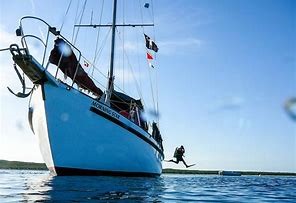 Blackbeard’s Sailboat Dive Cruise
June 6 - 12, 2020
Blackbeard’s Sailboat Dive Cruise
June 6 - 12, 2020
There is no better international dive trip bargain with this unique experience. One of the things you learn is that to secure the best accommodations and dates you want you need to book early. June and July are the best months to go and they always sell out a year in advance, and that’s why I put a deposit down early. Four adventurous divers have already signed up! See https://activedivers.org/Blackbeard_Cruise.html for the details and the handy “Deposit” button!
Some Exciting Caribbean Location, July 2020
I don’t know where this will be yet, but you can bet it will be another action packed Active Divers trip. I usually wait until the fall DEMA show offers come out but I also listen to your suggestions so email me at diverdaryl@bellsouth.net with you ideas.
![]()
Date: Saturday, May 11, 2019, 9am to 1pm
Location: A.D. Barnes Park Park Pool, 3401 SW 72 Avenue, Miami, FL 33155 (305) 666-5883
Cost: Free to current paid-up Active Divers members; $25 one-day only membership promotion for certified divers wishing to join Active Divers at the event – offer available to new members only. New membership valid only through December 31, 2019.

Events and Activities: The day consists of two hours of scuba tune-up clinics taught by Active Divers Safety Officers, followed by two hours in the water in small groups working on scuba skills with a Safety Officer. Clinic topics include buoyancy, pressure, breathing, the Buddy System, communication, hand signals, the underwater environment, dive planning and safety. The pool session with full scuba gear will cover the typical pool skills taught in the Open Water course. Note: This is not the official PADI scuba refresher course and participants do not receive any certification for this event. Lunch: Poolside lunch served after the pool session compliments of Active Divers.
Equipment Rental: Members and Non-Members may bring their own gear or rent gear at the event for an additional $44 which includes tank, regulator, BCD, belt and weights. Members and non-members must provide personal mask, fins, and snorkel.
Spread the Word and Bring Your Friends! We want to use this event to get in as many new members as possible, so please spread the word and bring your friends. There will not be another opportunity to join Active Divers for just $25 for the rest of the year.
For more information, please contact Rachel Davis at rachelhancock7@gmail.com or call 786-316-9852.
To register for the event, fill in the form located at Scuba Skills Workshop. You may also prepay for the event and rent equipment on this page, as well. Please note that credit card payments will not be accepted on the day of the event.
Please Note: You must bring a valid scuba certification card to the event.
![]()
--by John Davis

Tiger Shark
As the official 2019 Active Divers season gets under way, I thought it would be a good time to remember why I love diving.
In 2012, I got certified as an open water diving by my wife Rachel Davis. As a testament to her patience and persistence I not only completed Open Water certification, but also have obtained my Advanced Open Water and Rescue Diver certifications. Anyone in Active Divers who remembers me going on the first International trip to Tobago will remember that it was even hard to get me in the water to snorkel.
So, how did I fall in love with diving? It has been a process of working through my own fears of drowning, and fear of sea creatures for which I had no understanding. The short answer is that I simply kept jumping back in after I had a particularly challenging dive. I realized that the only way I was going to learn was by doing another dive. To date I have over 380 dives. Compared to the standards of those who have been diving for decades this number doesn't sound very exciting. But, for me it is unbelievable. To date I have been diving in Costa Rica, Honduras, Mexico, Jamaica, Bonaire, St. Thomas, Bahamas, Barbados, Belize, Australia, and Cayman.
What has also kept me diving is the social aspect of this sport. I have met and become friends with so many great people along the way. Divers are some of the most caring people I have ever met. Part of the code every diver adheres to is the commitment we have to look out for each other. There is a great spirit of teamwork involved in diving. We always dive in buddy teams, there are safety briefings, and the trips we go on as a group always bring us closer together. I believe that diving is a way to bring people together. And, it's not just the social aspect, but it's the concern for our planet that is so inspiring to me. Active Divers is always looking to get involved in projects such as Aquarius and Coral Restoration Foundation as ways of furthering our mission of doing good in the world. We divers are actively seeking to make the oceans healthier. We know better than most that when we care for the ocean, we are caring for all of humanity.
For these reasons and more I am looking forward to another great dive season! More connections with great friends, and more unknown adventures await us all. Thank you for being such a great part of my life!
![]()

Three years ago, eleven members of Active Divers experienced an adventurous full-day mission to the Aquarius underwater laboratory and habitat. Submerged since 1993 in sixty feet of water in the Florida Keys Marine Sanctuary nine miles offshore, Aquarius is the world’s only permanent underwater laboratory. It provides a platform for the study and preservation of marine ecosystems worldwide. Aquarius is a globally significant facility that offers a unique means to study the ocean, test and develop state-of-the-art technology, and train specialized divers and NASA astronauts. The habitat can accommodate up to six guest divers for long term missions of up to ten days, or even longer. Divers are able to experience long missions through a technique called “saturation diving,” in which they adapt to cabin pressure equal to the outside water pressure, and then decompress in a hyperbaric chamber for fifteen hours at the end of the mission.
 The outside
of the structure looks like you would expect for a sunken vessel
that has been on the ocean floor for more than twenty years. The
surface is crusted with barnacles, corals and sponges, and the
area around Aquarius is teeming with fish of all sizes and
species. A nearby separate structure called the Gazebo is a
white-colored roof holding air inside that is essentially a diving
bell. The Gazebo provides a place for scuba diving researchers to
stand up with their heads above water, to take off their masks and
regulators to breathe the captured air for a while during breaks
from projects on the sea bottom. The Gazebo also is the emergency
escape location should Aquarius catch on fire or should another
urgent emergency arise during a mission.
The outside
of the structure looks like you would expect for a sunken vessel
that has been on the ocean floor for more than twenty years. The
surface is crusted with barnacles, corals and sponges, and the
area around Aquarius is teeming with fish of all sizes and
species. A nearby separate structure called the Gazebo is a
white-colored roof holding air inside that is essentially a diving
bell. The Gazebo provides a place for scuba diving researchers to
stand up with their heads above water, to take off their masks and
regulators to breathe the captured air for a while during breaks
from projects on the sea bottom. The Gazebo also is the emergency
escape location should Aquarius catch on fire or should another
urgent emergency arise during a mission.
The laboratory itself forty-three feet long, twenty feet abeam, and sixteen feet six inches tall. It is attached to a baseplate that positions the underwater habitat about thirteen feet off the bottom. This means that the working depth of those inside the laboratory is about fifty feet deep, which is the atmospheric pressure maintained within the habitat.
Divers approach Aquarius from the bottom, entering an area called the “moon pool,” within which there is a broad shelf around the sides called the “wet porch.” Divers can kneel on the porch floor with their heads above water, take off their gear and leave it outside while visiting the habitat. Once inside each diver is asked to take a fresh water shower and put on a dry shirt from the dry pot that has ferried down our cell phones and other articles that should be keep dry.
![]()
My diving experiences began in the summer of 1972. Since then, or at least when I began to understand the dangers of scuba, which truthfully was much later than sooner, prompted me to begin searching for ways to dive safer through training or improved technology. This year my technology search led me to the SCUBAPRO G2 dive computer.
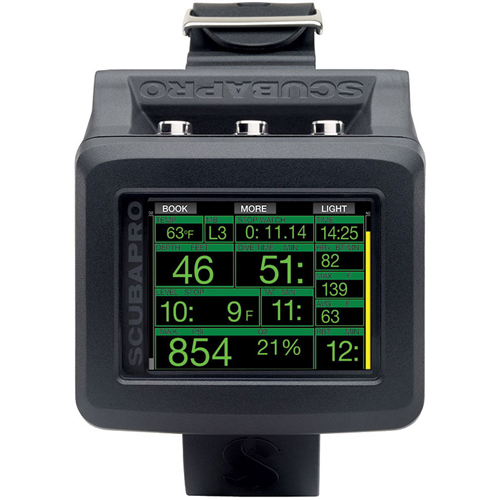 Currently,
statistics show that even though the population of divers has
grown immensely, injuries have drastically dropped. The lack of
customers resulted in the inability to keep up with the cost of
the hyperbaric chamber programs, causing the closure of many
decompression treatment facilities.
Currently,
statistics show that even though the population of divers has
grown immensely, injuries have drastically dropped. The lack of
customers resulted in the inability to keep up with the cost of
the hyperbaric chamber programs, causing the closure of many
decompression treatment facilities.
The reason there are fewer injuries is a combination of better trained divers and improved equipment. The dive industry feels that better technology is largely responsible for fewer injuries. Advances in BC’s, dive computers, and regulators are just a few of the significant improvements that have contributed to a safer dive environment. Computers have played a major role in accident reduction. The information received from the dive computers technology is endless. Computers beep at any diver’s failure to complete requirements or behavior that can trigger injuries. It’s like diving with your “Mom”.
One such device is the G2 computer from Scubapro. The G2 has every feature imaginable for an individual’s preference. Multi-color displays, adjustable algorithm, the ability to change gasses while diving, adjustable displays, diver’s breathing rate, heart rate, and body temperature display during the dive, and 8 Nitrox and Trimix programs. The G2’s capabilities are too many to mention in this article. Don’t be overwhelmed. Remember that your laptops and Home computers are far more powerful than most of us can comprehend. We purchase the dive computer that appeals to the individual’s visual taste and technological capabilities even though we probably are incapable of utilizing all of them. I find that the G2 can accommodate the needs of any diver’s skill level and continue to be an asset as their experiences progress.
![]()
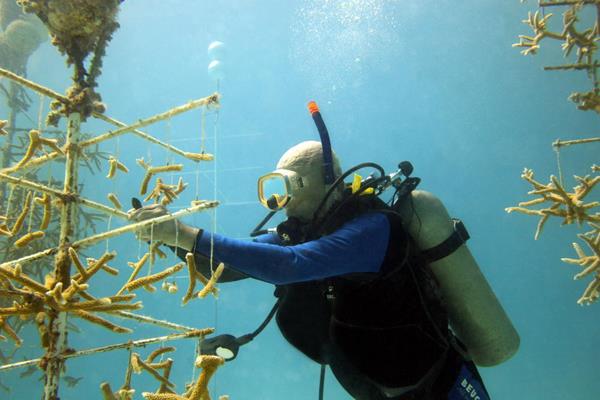 If you love the splendor of
colorful tropical reefs (and what diver doesn’t?), now is the
time register for one of the remaining slots in our 2019
Active Divers collaborative program with the Coral Restoration
Foundation. This year’s event is on Saturday, June 15. If you join
us that day, I can assure you that you will feel an unparalleled
sense of satisfaction when you see tiny coral specimens you
transplant onto a barren reef grow and mature,
If you love the splendor of
colorful tropical reefs (and what diver doesn’t?), now is the
time register for one of the remaining slots in our 2019
Active Divers collaborative program with the Coral Restoration
Foundation. This year’s event is on Saturday, June 15. If you join
us that day, I can assure you that you will feel an unparalleled
sense of satisfaction when you see tiny coral specimens you
transplant onto a barren reef grow and mature,
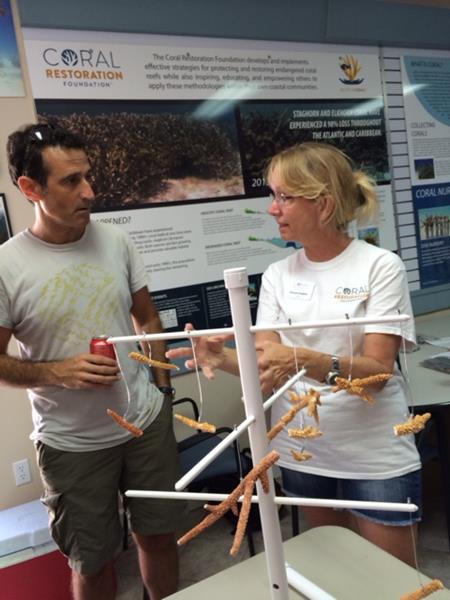 Don’t know anything about
marine science and coral transplanting techniques? There is no
need to worry. CRF trains every diver in morning lecture and
hands-on sessions in its state-of-the-art facility, located at 5
Seagate Blvd in Key Largo, right next door to the Pilot House
Restaurant. There we will learn some of the science about threats
to the reef systems; the latest techniques for taking cutting and
prepping baby corals for outplanting, how to transplant specimens
onto the reef, maintaining previously-planted coral garden,; and
documenting the successes of our efforts.
Don’t know anything about
marine science and coral transplanting techniques? There is no
need to worry. CRF trains every diver in morning lecture and
hands-on sessions in its state-of-the-art facility, located at 5
Seagate Blvd in Key Largo, right next door to the Pilot House
Restaurant. There we will learn some of the science about threats
to the reef systems; the latest techniques for taking cutting and
prepping baby corals for outplanting, how to transplant specimens
onto the reef, maintaining previously-planted coral garden,; and
documenting the successes of our efforts.
After classroom and onshore laboratory work that morning, our group will enjoy a delicious lunch from Pilot House or one of the other seafood specialty restaurants in the vicinity, sharing stories about reef restoration and marine ecology efforts with experts in the field. Then we will travel the quick, nine-mile trip to Florida Keys Dive Center in Tavernier, where we will load our gear on the boat and head out to the coral nursery and reefs to put our classroom training into effect.
![]()
 What does a human have in
most common to the dolphin? If you answered the brain, you are
absolutely correct. They also have a large and complex brain.
The question isn’t how smart they are, but how are they smart?
Is it much different than a human? In fact, the dolphin brain is
more complicated with its’ network of gyri and sulci (ridges and
grooves of the brain) (just got done with my brain study course,
sure) than us. Gee, that makes me feel stupid, ok, I know what
you are thinking. But that includes you too. They also have more
blood flow than us, we are looking bad. But that has the effect
of feeding their high metabolism (maybe that’s why we never see
a fat one) needed for marine living.
What does a human have in
most common to the dolphin? If you answered the brain, you are
absolutely correct. They also have a large and complex brain.
The question isn’t how smart they are, but how are they smart?
Is it much different than a human? In fact, the dolphin brain is
more complicated with its’ network of gyri and sulci (ridges and
grooves of the brain) (just got done with my brain study course,
sure) than us. Gee, that makes me feel stupid, ok, I know what
you are thinking. But that includes you too. They also have more
blood flow than us, we are looking bad. But that has the effect
of feeding their high metabolism (maybe that’s why we never see
a fat one) needed for marine living.
That brain also has the ability for sensing things with sound. Did we lose ours or did we never have that sense? This works fast in the ocean since the echoes travel four times as fast in water. Hmmm, maybe we lost it when we started on land?
Here’s a weird one. Some males team up to get a female away from her companions. Once separated, one of the males will engage in sex with her. Humm, if it was a human, they would all be doing it. Maybe they are smarter.
They also work together for feeding. A group will charge a group of fish and force them on land by making waves that push them through the surf. Then they beach themselves and have a feast.
Lastly, they remember each other by each dolphin’s distinctive whistle. Two dolphins can lose contact with one another for over twenty years, but much like the sound of someone’s voice, the dolphin’s whistle is uniquely identifiable.
![]()
For the
past several years, our kick-off and end-of-season picnics have
been held at the Jetty Pavilion of Dr. Von D. Mizell-Eula
Johnson State Park (formerly known as John U. Lloyd State Park).
However, beach erosion has taken its toll on the site, resulting
in a very steep embankment for shore diving, coupled with
exposure of sharp rocks on the entry. At the end of last year
Rachel and Jerry scouted out beach diving sites for every
pavilion at the park and found the entries difficult due to
severe erosion at all of them, with no firm commitment by the
park to fix the problem in the near term.
So this
year we went a different direction. The Blue Heron Bridge dive
site at Phil Foster Park in Riviera beach is world-famous, named
the Best Shore Dive in the U.S. by Scuba Diving Magazine. There
is so much to see here just a flat, easy walk from shore. Even
though this is the Intracoastal Waterway and not the ocean,
swift currents moving through daily ensure the marine life is
always varied and abundant.
On this day the seas were less than 1 foot, and we saw several bait balls of silversides, huge yellow cushion starfish, a batfish, an octopus in a bottle, sharp-tailed eel devouring a small crab, abundant schools of Altantic spadefish, and too many large arrow crabs to count. Check out our video of the day's dive to see all the amazing creatures.
![]()
During the 1960's, when ADA was still embryonic, diving was in the dark ages in many ways. The first big difference was the scuba tank. Steel 72 cubic feet tanks were available, as well as and some smaller volume tanks, but the aluminum 80 was yet to be invented. The aluminum 80 tank provided more air, positive buoyancy when empty, and is virtually rustproof service, all beneficial improvements.
Next came air monitoring devices. Underwater pressure gauges were available, but not common. Instead, tanks were fitted with reserve valves. The reserve valve was a spring-loaded mechanical device that when armed with the lever in the up position, restricted air flow when tank pressure dropped down below 500 psi. In theory, the diver would feel the breathing resistance, reach back and flip the lever down, alerting the diver that 500 psi or less remained in the tank. Forgetting to put the lever up at the beginning of the dive or weakened springs could be problematic. On one Active Divers trip to the Bahamas, we discovered that the reserve valve on one of our tanks had been installed upside down by the dive operator, and when pulled, actually cut off the air supply.
BCDs? Not yet. Instead, some of us safety-minded divers scrounged CO2 cartridge life vests, commonly provided by airlines for their passengers. Pacific Divers Supply in California offered a similar vest for $16. But most macho divers thought they were sissified. Evolution is a slow process in nature and the diving world but look how far we have come.
Being on the ocean you might think it is endless and nothing could happen to it. This could not be farther from the truth. Here we go: -
- There are approximately 400 “dead zones” in coastal areas, that is where the oxygen levels are very low
- Deep coral reefs are now being destroyed by deep trawlers. The reason this happens is because the other areas are less productive
- In the Caribbean 80% of the reefs are dead. - 50% of the reefs globally are gone.
- The ocean’s PH Is changing for the worse.
- Some previously common fish have just about disappeared from the oceans; tuna, cod and eel are among the casualties.
- Tons of waste products have entered the oceans.
So, what are we to do? Education is key. Become aware of the problem and voice your concerns where they count. Don’t be silent!
![]()
Want your newsletter delivered via snail-mail? Contact the webmaster and request a printed copy. Be sure to put "Active Divers Newsletter" in the subject.
![]()
If so, please email or call us with your current information. You may send an email to: Dr. Dan Baeza, Membership Chair at ActiveDiversInfo@gmail.com. You can also call Dan at 954-260-8225 and leave a message with your new contact information.
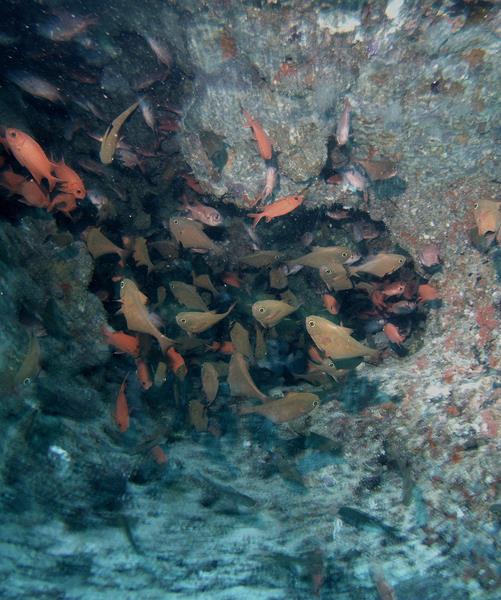
Active Divers
T-Shirts For Sale
After nearly 50 years, we've revamped our logo!
Show your pride in the best dive club anywhere and pick up a tee with a brand new logo. Sizes small, medium, large, xlarge, xxlarge. Some tank tops available also. All shirts are $10 each. CALL LON AT 305-251-4975 AND PLACE YOUR ORDER TODAY!. Lon will deliver it to you on your next dive.
Hover over the t-shirt to see a close-up of the logo in detail.
--Reprinted from wiseGEEK
Although we typically think of jungles and rain forests such as the Amazon as being the "lungs" of the planet, that's not exactly true. Although we do owe much of the planet's oxygen to trees and other land plants, at least half of the oxygen actually comes from the oceans. A key component of ecosystems in oceans, seas, and freshwater basins, the photosynthesizing microorganisms known as phytoplankton contribute an estimated 50 to 85 percent of the oxygen in the Earth’s atmosphere. You’re probably breathing oxygen right now that was produced by these single-celled plants.
Tiny plants with a big role:
- The name "phytoplankton" comes from the Greek words phyton (meaning plant) and planktos (meaning wanderer or drifter).
- Phytoplankton are too small to be seen individually, but in large numbers, they are noticeable as colored patches on the water surface, appearing green because of the plant’s chlorophyll content.
- Phytoplankton use energy from the sun to convert carbon dioxide and nutrients into organic compounds, which form new plant material and create oxygen in a process known as photosynthesis.


